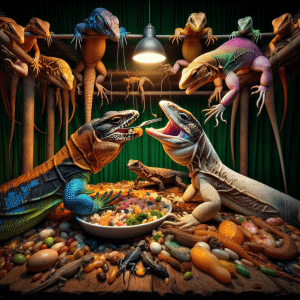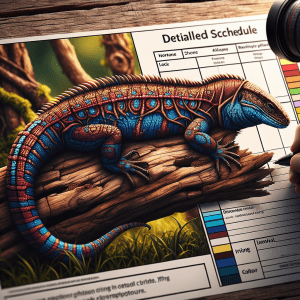Importance of a Proper Lizard Feeding Nutrient Schedule
Have you ever stopped to think about the importance of a proper lizard feeding nutrient schedule? It may seem like a small detail, but trust me, it can make a huge difference in your pet lizard’s health and well-being.
Imagine this – a few years back, when I first got my pet lizard, I didn’t pay much attention to its diet. I would feed it whatever was convenient without considering the nutritional value. But as time passed, I started noticing changes in its behavior and overall health. That’s when I realized the significance of providing a balanced and nutritious diet tailored to my lizard’s needs.
Understanding your lizard’s dietary requirements is key to ensuring its vitality and longevity. Just like us, lizards have specific nutritional needs that must be met to thrive. By creating a well-rounded diet plan with the right balance of protein, fruits, vegetables, and supplements, you can support your pet lizard’s overall health.
When it comes to feeding your lizard, it’s essential to know which food items are suitable and which ones to avoid. From crickets and mealworms to leafy greens and fruits, there is a variety of options to choose from. However, not all foods are created equal, so it’s crucial to select items that provide the necessary nutrients for your lizard’s growth and development.
Maintaining a consistent feeding schedule and portion control is equally important. Overfeeding or underfeeding can lead to health issues, so it’s essential to monitor your lizard’s food intake and adjust as needed. Additionally, incorporating supplements and vitamins can help fill any nutritional gaps and promote optimal health.
By following these guidelines and regularly monitoring your lizard’s health, you can ensure that your pet thrives on a nutritious diet. Remember, a well-fed lizard is a healthy and happy lizard!
Understanding Your Lizard’s Dietary Needs
Have you ever stopped to think about what your lizard really needs in terms of their diet? It’s fascinating how much their dietary needs can differ from other pets. When I first got my bearded dragon, I was surprised to learn about the specific nutrients and food items crucial for their health. Understanding your lizard’s dietary needs is like uncovering a hidden world of nutrition tailored for these unique reptiles.
Lizards are not like your typical household pets when it comes to food. They have specific dietary requirements that need to be met to ensure they stay healthy and happy. It’s essential to remember that different species of lizards may have varying dietary needs. For instance, while some lizards are primarily insectivores, others may require a more plant-based diet. Understanding these distinctions is key to providing the best care for your scaly friend.
Let’s dive into the fascinating realm of lizard nutrition. Did you know that certain lizards, such as iguanas, need a diet rich in leafy greens and vegetables to thrive? It’s incredible how their bodies have evolved to require such specific nutrients for optimal health. By learning about your lizard’s dietary needs, you can tailor their diet to mimic what they would eat in the wild, promoting their overall well-being.
Exploring your lizard’s dietary requirements can be both enlightening and rewarding. As you delve into the world of lizard nutrition, you’ll gain a deeper appreciation for these incredible creatures and the intricate balance of nutrients that keep them healthy. So, why not take a moment to consider what’s on your lizard’s menu and ensure they are getting the nutrients they need to lead a vibrant and fulfilling life?
Creating a Balanced Diet Plan for Your Pet Lizard
Let me tell you about creating a balanced diet plan for your pet lizard. When it comes to feeding your scaly friend, it’s essential to ensure they are getting all the necessary nutrients to stay healthy and happy.
Now, imagine this: just like us, lizards need a variety of foods to meet their dietary requirements. It’s not just about throwing in some insects and calling it a day. To create a balanced diet plan, you need to consider the specific needs of your lizard species. For example, some lizards are primarily herbivores, while others are carnivores or omnivores.
Here’s an interesting fact for you: did you know that certain lizards require a higher protein intake, while others may need more fruits and vegetables in their diet? Understanding your lizard’s natural diet in the wild can give you valuable insights into what to feed them in captivity.
When planning your lizard’s meals, it’s crucial to offer a variety of food items to ensure they are getting all the essential nutrients. Include a mix of gut-loaded insects, leafy greens, fruits, and even the occasional treat like calcium-rich mealworms. By diversifying their diet, you can help prevent nutritional deficiencies and promote overall health.
To keep things simple, you can create a weekly meal plan for your lizard, outlining which foods to offer each day. This can help you stay organized and ensure your pet is receiving a balanced diet consistently. Remember, moderation is key, so be mindful of portion sizes and avoid overfeeding your lizard.
By taking the time to create a balanced diet plan tailored to your lizard’s specific needs, you are setting them up for a long and healthy life. So, grab that shopping list and start preparing a menu that will keep your scaly companion thriving!
Recommended Food Items for Lizard Nutrition
When it comes to providing the best nutrition for your pet lizard, knowing the recommended food items is crucial. I remember when I first got my bearded dragon, and I was overwhelmed by the variety of foods available for them. It was a bit like being a chef for a picky eater, trying to find the perfect menu to keep my scaly friend happy and healthy.
One interesting fact about lizard nutrition is that different species have specific dietary requirements. For example, herbivorous lizards like iguanas need a diet rich in leafy greens and vegetables, while insectivorous lizards such as leopard geckos thrive on a diet of live insects. Understanding your lizard’s natural diet in the wild can help you replicate those food choices in captivity.
To ensure a balanced diet for your lizard, it’s essential to offer a variety of food items that cater to their nutritional needs. Incorporating a mix of gut-loaded insects, leafy greens, fruits, and calcium supplements can help provide the essential nutrients your lizard requires to stay healthy. Remember, diversity is key when it comes to creating a well-rounded menu for your scaly companion.
One practical tip when selecting food items for your lizard is to avoid feeding them foods that are toxic or harmful to their health. Some common foods to avoid include avocado, rhubarb, and citrus fruits, as they can be toxic to reptiles. Always research and double-check the safety of any new food items before offering them to your lizard.
By following these guidelines and providing a diverse selection of recommended food items, you can ensure that your pet lizard receives the balanced nutrition they need to thrive. Remember, a well-fed lizard is a happy lizard!
Feeding Frequency and Portion Control for Lizards
Feeding frequency and portion control for lizards play a crucial role in maintaining their health and well-being. You see, just like us, our scaly friends also need a balanced diet and appropriate feeding schedule to thrive.
Let me share a personal anecdote with you – when I first got my pet lizard, I was a bit overwhelmed with the amount of conflicting information out there regarding how often and how much to feed it. I soon learned that establishing a consistent feeding routine is key to keeping your lizard healthy.
Now, here’s the deal – lizards have different dietary requirements based on their species, size, and age. Some lizards are herbivores, while others are insectivores or omnivores. This means you need to tailor their diet accordingly to ensure they’re getting the right nutrients.
When it comes to feeding frequency, it’s essential to strike a balance. Overfeeding can lead to obesity and health issues, while underfeeding can result in malnutrition. Generally, adult lizards should be fed every 1-2 days, while juvenile lizards may require daily feeding to support their growth.
Portion control is another important aspect to consider. You want to offer the right amount of food that your lizard can consume in one sitting without leaving leftovers that could spoil and attract pests. It’s a good idea to observe your lizard’s eating habits and adjust the portion size accordingly.
Remember, hydration is also crucial for lizards, so make sure to provide fresh water in a shallow dish at all times. Some lizards may also benefit from occasional misting to maintain proper hydration levels.
By understanding the feeding frequency and practicing portion control, you can ensure that your pet lizard stays healthy and happy. So, next time you offer a meal to your scaly companion, keep these tips in mind for a happy and well-fed lizard!
Supplements and Vitamins for Optimal Lizard Health
Have you ever wondered if your pet lizard is getting all the essential nutrients it needs to stay healthy and active? Well, let’s dive into the fascinating world of supplements and vitamins for optimal lizard health.
When it comes to keeping our scaly friends in top shape, it’s crucial to ensure they are receiving all the necessary vitamins and minerals in their diet. Just like us, lizards can benefit from a little boost now and then to support their overall well-being.
One interesting fact about lizard nutrition is that different species have varying dietary requirements. Some lizards may need more calcium for strong bones, while others might require additional vitamins to support their immune system. It’s essential to understand your specific lizard’s needs to provide them with the right supplements.
Now, let’s talk about practical tips for incorporating supplements into your lizard’s diet. You can easily sprinkle powdered supplements over their food or offer them as treats. Just remember to follow the recommended dosage instructions to avoid over-supplementing, which can be harmful to your pet.
Monitoring your lizard’s health is key when introducing new supplements. Keep an eye out for any changes in behavior, appetite, or physical appearance that may indicate a reaction to the supplements. If you notice any concerns, consult a reptile veterinarian for guidance.
So, next time you’re preparing your lizard’s meal, consider adding a sprinkle of vitamins to keep them in top shape. By providing the right supplements tailored to your lizard’s needs, you can ensure they lead a happy and healthy life. Your scaly friend will thank you for it!
Monitoring Your Lizard’s Health and Adjusting the Feeding Schedule
Imagine we’re discussing the topic of monitoring your lizard’s health and adjusting the feeding schedule over a cup of coffee. So, here’s the deal – just like us, our reptilian friends need a little extra care and attention to stay healthy and happy.
Let me share a personal anecdote with you. I once had a pet lizard named Spike, who was a picky eater. I learned the hard way that monitoring his health was crucial to ensure he was getting the right nutrients. By keeping a close eye on his eating habits and overall well-being, I was able to make adjustments to his feeding schedule and diet to keep him in top shape.
Now, here’s a practical tip for you. It’s essential to regularly observe your lizard’s behavior and appetite. If you notice any changes, such as decreased appetite, weight loss, or unusual lethargy, it could be a sign that something is amiss. By being proactive and adjusting their feeding schedule or seeking veterinary advice when needed, you can address any health issues promptly.
Let’s not forget the significance of this topic. Monitoring your lizard’s health and adjusting their feeding schedule isn’t just about keeping them well-fed. It’s about fostering a strong bond with your pet, ensuring their longevity, and providing them with the best care possible. Remember, our scaly companions rely on us to look out for their well-being.
So, next time you’re feeding your pet lizard, take a moment to observe their behavior and make sure they’re thriving. A little extra attention could make all the difference in keeping your reptile friend healthy and happy for years to come.
Ensuring Your Pet Lizard Thrives with a Nutritious Diet
Imagine this scenario: You’ve been diligently following a nutrient schedule for your pet lizard, ensuring they get all the essential vitamins and minerals they need. But suddenly, you notice a change in their behavior or appearance that raises a red flag. What do you do next? Monitoring your lizard’s health and being observant is just as crucial as sticking to a feeding plan.
It’s like being a detective, but instead of solving a mystery, you’re safeguarding your scaly friend’s well-being. By staying vigilant and regularly checking on your lizard, you can pick up on any subtle signs that might indicate a health issue. Whether it’s a change in appetite, unusual lethargy, or skin problems, being attuned to these cues can help you catch potential problems early on.
Now, let me share a personal anecdote related to this. A friend of mine once noticed that their pet lizard was shedding more frequently than usual. Initially, they brushed it off as a natural process, but upon closer inspection, they realized it was a sign of nutritional imbalance. By adjusting the lizard’s diet and consulting with a reptile vet, they were able to address the issue before it escalated.
The key takeaway here is that no matter how well you plan your lizard’s diet, staying proactive and observant is paramount. Your lizard can’t tell you when something is wrong, so it’s up to you to be their advocate and caretaker. Remember, a healthy and happy lizard is a product of not just what they eat but also how well you monitor their overall health. Keep a keen eye out, and you’ll be well on your way to ensuring your scaly companion thrives for years to come.




